Doc's Anything Goes
Currently Offline
Posts: 371  Likes: 18
Likes: 18
Joined: Jun 13, 2014 16:48:23 GMT -6
|
Post by glavey on Jun 1, 2015 7:10:40 GMT -6
Every build log I see that involves welding makes me think more and more about learning how to weld and upgrading from my miniscule 80 amp buzz box stick welder.
|
|
Doc's Anything Goes
Currently Offline
Posts: 371  Likes: 18
Likes: 18
Joined: Jun 13, 2014 16:48:23 GMT -6
|
Post by glavey on Jun 1, 2015 7:08:55 GMT -6
Wow that thing is tiny! The engine is half the size of the entire frame. Makes me think of all of those franken-scoots/franken-bikes/franken-karts I see on youtube with gixxer motors shoved in them.
Is it going to be just for back alley bashing or are you going to try and race it?
|
|
Doc's Anything Goes
Currently Offline
Posts: 371  Likes: 18
Likes: 18
Joined: Jun 13, 2014 16:48:23 GMT -6
|
Post by glavey on Jun 1, 2015 6:56:08 GMT -6
I'm waiting for temperatures above 50 degrees.
|
|
Doc's Anything Goes
Currently Offline
Posts: 371  Likes: 18
Likes: 18
Joined: Jun 13, 2014 16:48:23 GMT -6
|
Post by glavey on May 29, 2015 3:11:47 GMT -6
Ok, I'll lie to you, but I'd be lying to you.
Many cars of my model year have the same problem; there was something like a defective top/clear coat on those specific cars.
|
|
Doc's Anything Goes
Currently Offline
Posts: 371  Likes: 18
Likes: 18
Joined: Jun 13, 2014 16:48:23 GMT -6
|
Post by glavey on May 28, 2015 19:40:14 GMT -6
Little bit of progress with the solar charger today. I got it wired up with more substantial wires and held in position temporarily with galvanized wire. 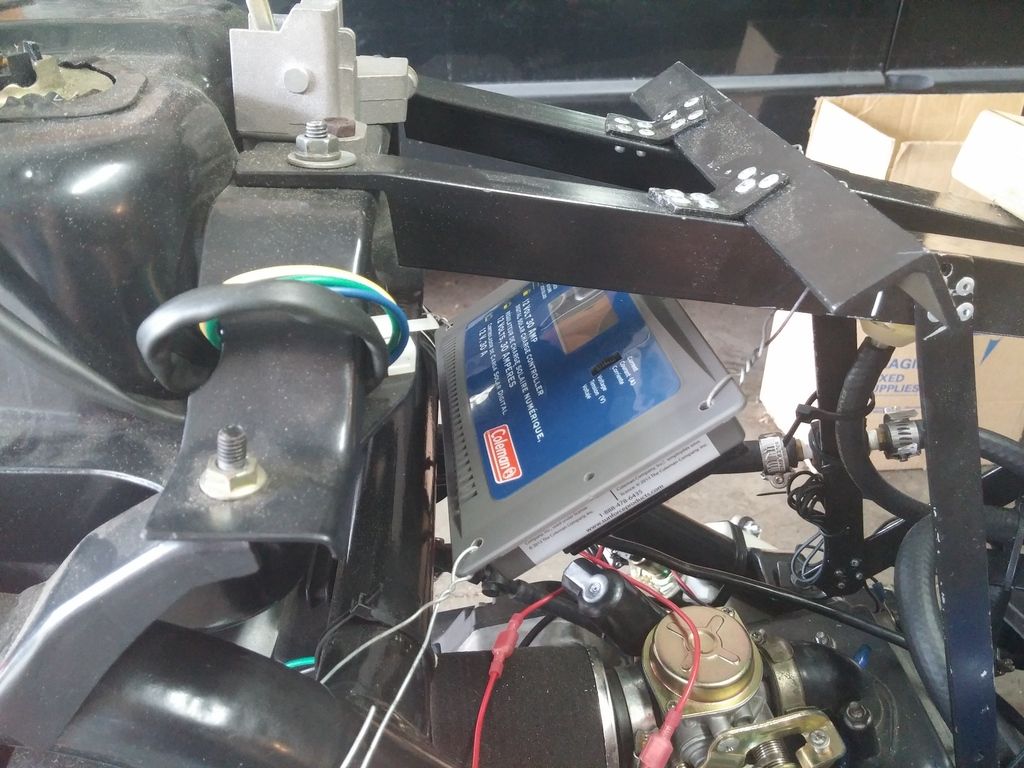  I tested the charger with the engine running from idle up to about 5-6k rpms. The battery voltage peaked at 14.7 volts when the charger was in its bulk charging mode and went as low as 13.8 volts during its float mode/topping off mode. The voltage coming out of the R/R stayed between 13 and 19 volts. The most amperage I saw the battery take was 0.3 amps (without the fuel/oil pump running). That might be because the battery was very near fully charged when I had the engine running. The solar charger can take up to 30 amps, so I have no worries that it will blow from over-current. I still have yet to remove the variable resistor that I was using before to control the charging voltage, but I have it set so that there is almost no voltage drop caused by it so I can still use the scooter until I remove it. One mistake I made today was thinking that a 30 volt, 3 amp rated circuit can take 36 volts and 2.2 amps. 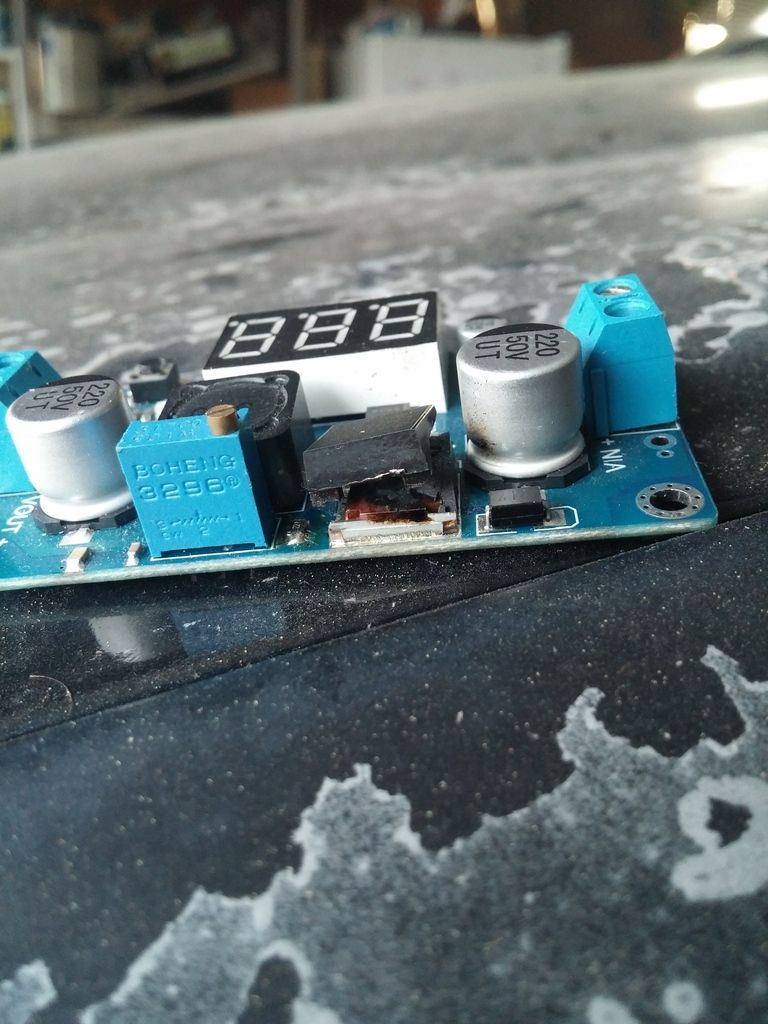 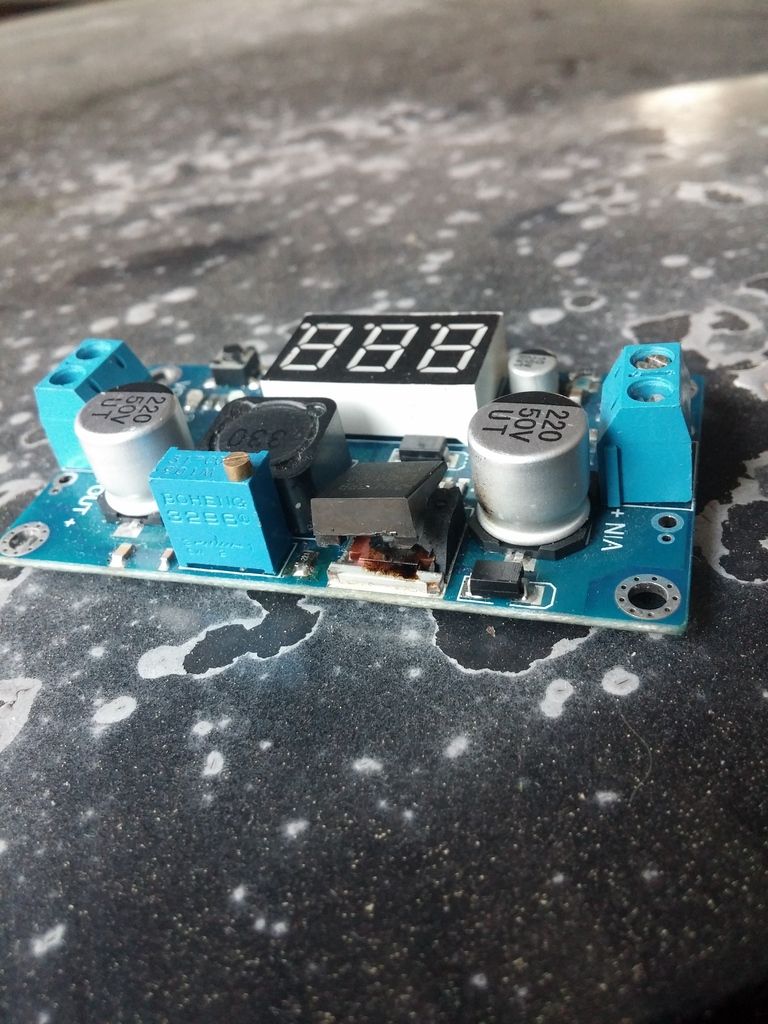 I didn't get hurt, just the one IC was blown, and the whole module was just a piece I use to test circuits with my arduino, so I haven't lost a whole lot. |
|
Doc's Anything Goes
Currently Offline
Posts: 371  Likes: 18
Likes: 18
Joined: Jun 13, 2014 16:48:23 GMT -6
|
Post by glavey on May 27, 2015 8:45:42 GMT -6
As you may have deduced with my lack of updates compared to when I was working on the oil cooler, I am more mechanically minded than electronically minded. I've gotten into the electronics hobby only recently, but I've been building stuff as long as I can remember. Also, my ADD combined with multiple projects, and the fact that once I start a new project I quickly loose interest in anything I was working on previously, makes progress slow and often unnecessarily difficult. Here are a few of the things I've been working on, in addition to the tachometer: Remember that laser engraver I talked about briefly? The limited work area got to me very quickly. I took inspiration from this product, which uses the same electronics as the engraver I bought, but has a much bigger working area. All I had to buy was the pieces of the metal frame, $2.88/each for 5 pieces, 2x stepper motors for $5 each (got a huge deal there, they normally go for about $15 each, 2x pulleys (in retrospect, I could have made my own) $8 for two, though I forgot I would actually need 3 Doh! , 5' of gt2 belt $4, and another Kg roll of printer filament (I was going to make all of the frame pieces myself) $20. I won't go into the build process, but the end result, after about a week of designing and re-designing parts, is this: 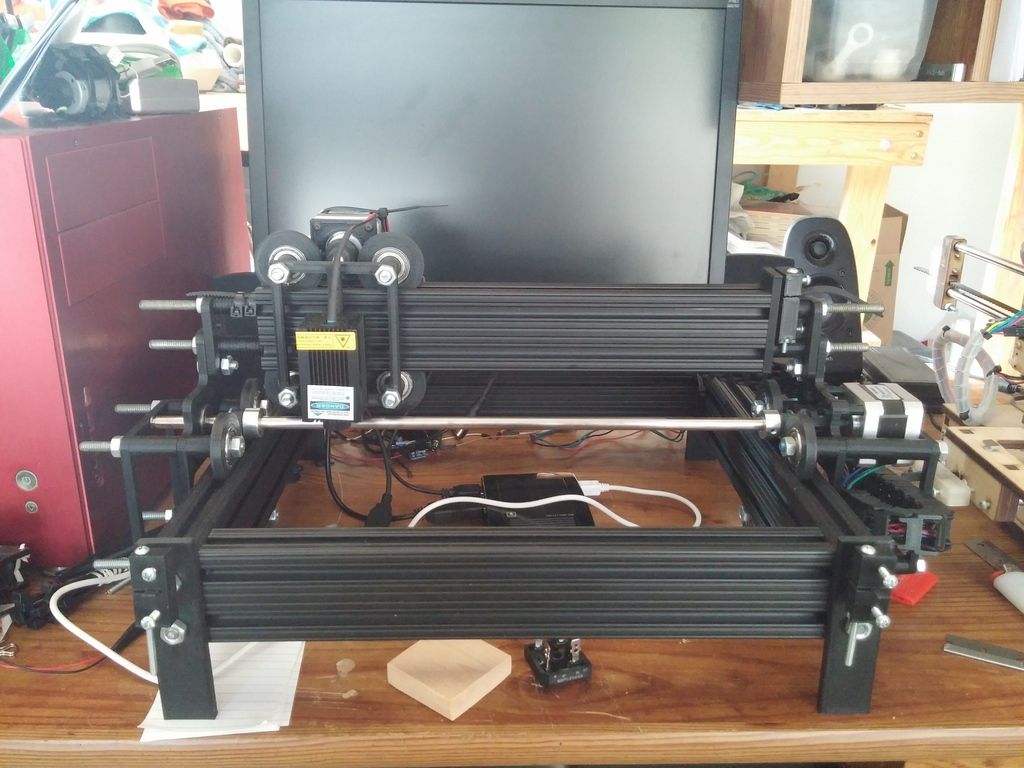 Now the (safe) print area is 200mm x 200mm; 5x more per axis than it was before. I have yet to get any software other than what came with the original engraver to work with it, but I'm pretty close. Next up is a very small project. As a soldering iron, I've been using one of those cheapo ones that plug directly into the wall, not regulated at all. My father used to make stained glass lamps and he used a dimmer switch to coarsely control the temperature of his soldering iron. I decided I would do the same. I salvaged an old computer power cord, connected it to a dimmer switch, and connected the dimmer switch to a dual outlet. I put the whole thing in a metal enclosure and printed a cover for the switches. Total cost: $2.05. I bought all of the electric parts minus the power cord from a local thrift store. I still need to buy/make a grommet so that the power cord going into the box isn't rubbing against sharp-edged metal. Here is the final product: 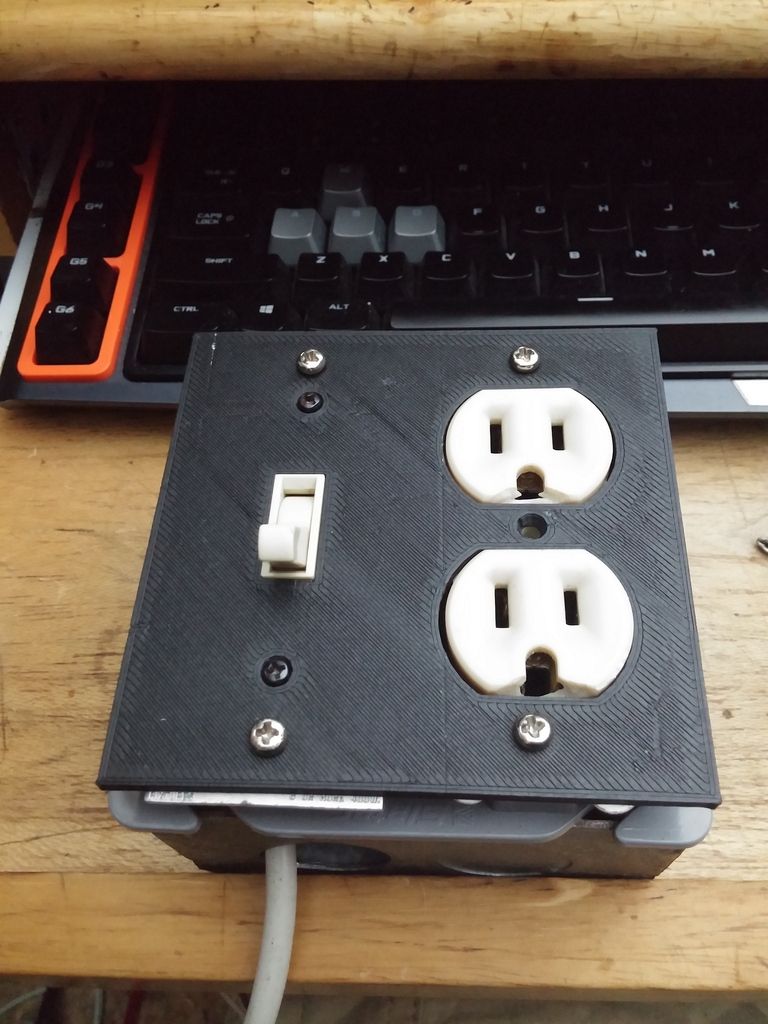 I tested it with the soldering iron I usually use, but that doesn't really make for good pictures as you can't see heat. Here it is with a lightbulb and an outlet adapter I keep next to the fuse box in case I have to determine which circuit a particular outlet or fixture is on: 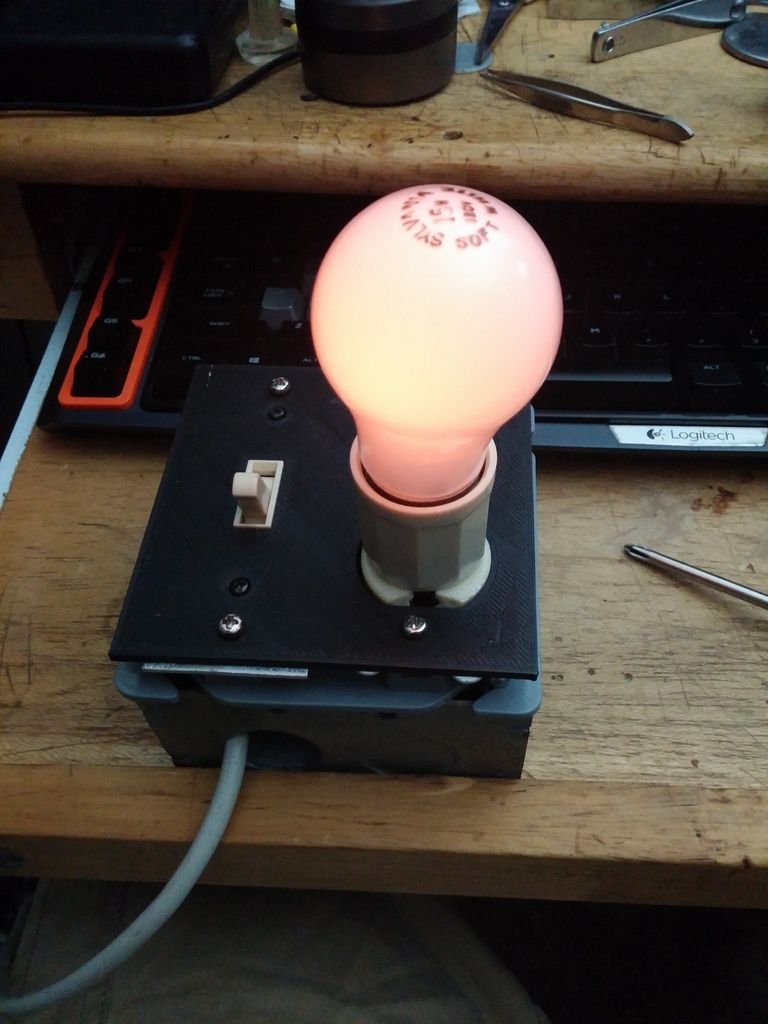 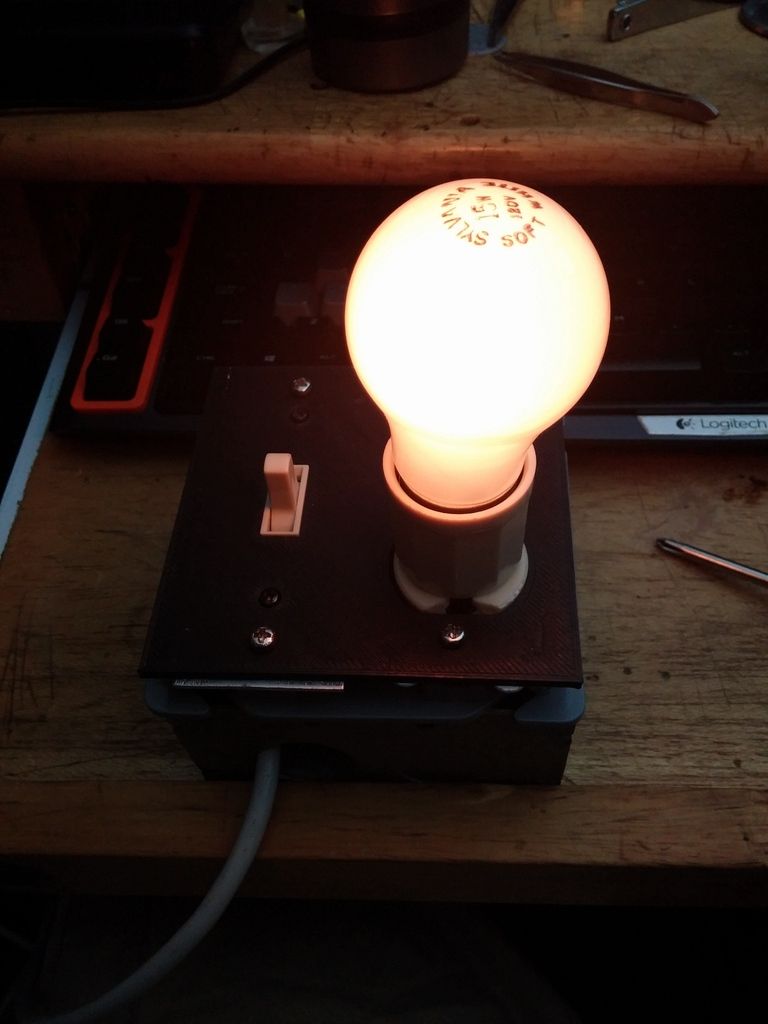 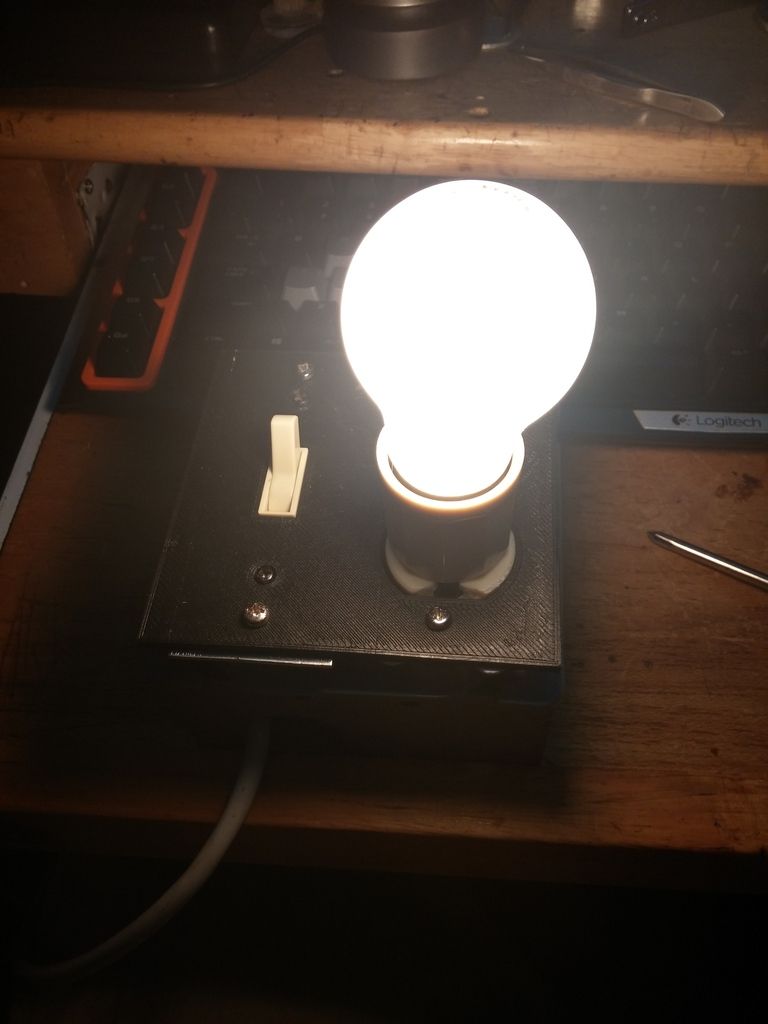 The third project I've been working on is using a solar charge controller to regulate the charging voltage going to the battery, instead of what I have now, which is a variable resistor I set to keep maximum voltage at around 14.3. The solar charge controller almost as a float mode charge controller - it reads the battery voltage and based on that is determines with how much voltage to charge the battery. The bulk of the charge is done at the usual 14.7 volts and once the battery is fully charges, it goes down to 13.5 volts to keep it topped off. It needs between 17 and 25 volts DC on the (solar array) input to charge the battery. I hooked up the charger to the scooter by taking the terminal from the regulator/rectifier that usually connects to the red wire and connecting it to the positive solar array terminal and connected the positive battery voltage to the red wire that usually comes from the regulator. Both grounds from the solar array and the battery were connected together and wired to chassis ground. Here's a few pictures showing the charger hooked up with two multimeters measuring the voltage coming out of the R/R before going into the charger (on the left) and the battery voltage, taken right at the battery (right). The engine wasn't running when I took these pictures, so the left meter is reading zero. The solar charger can display battery voltage or charging current. 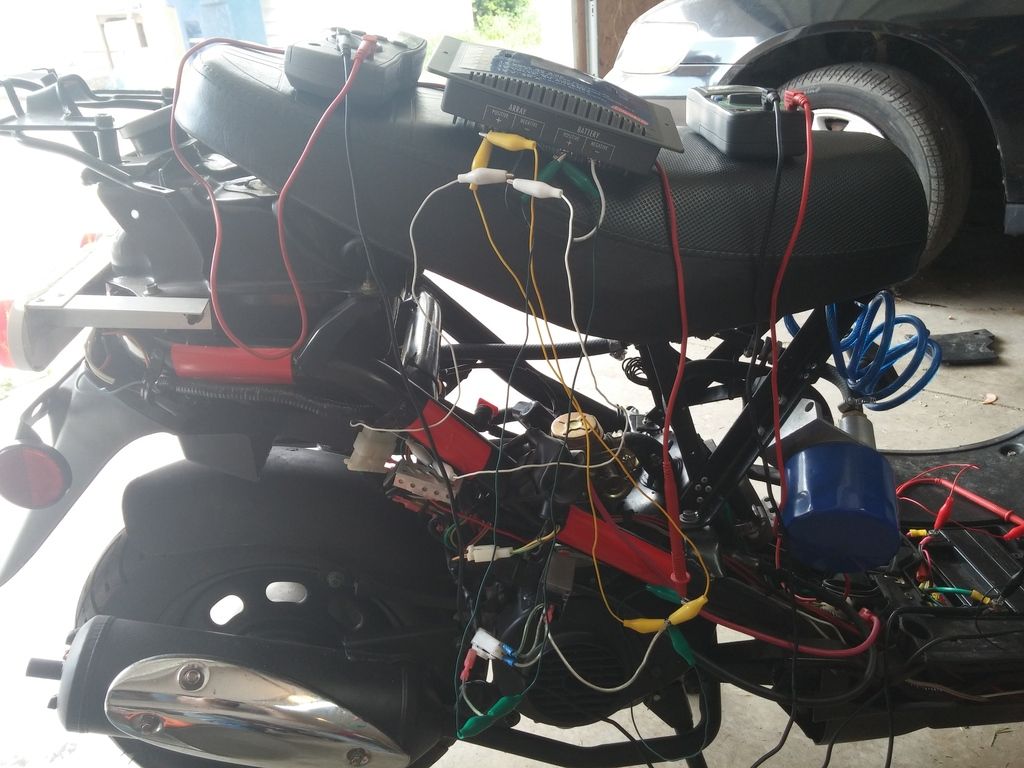  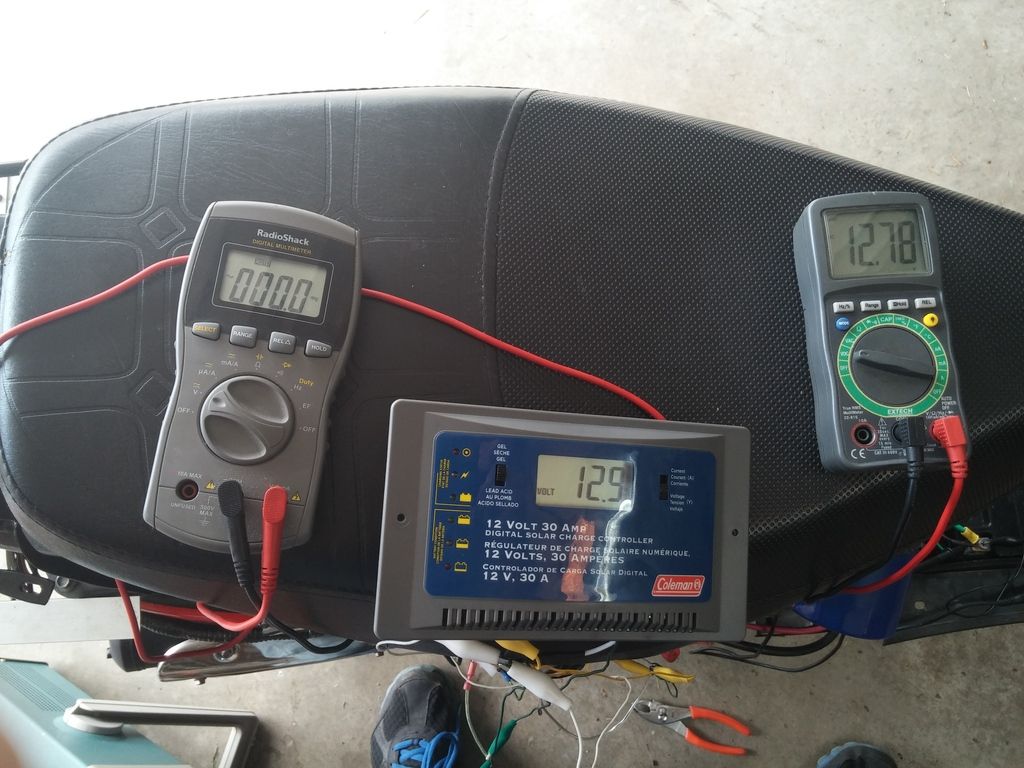 When I started the engine up the charger worked as it should. It took the voltage from the R/R, between 13 and 20 volts, and supplied the battery with up to 14.7 volts. I knew that the R/R for these scooters is only a half-wave rectifier, so I was curious how smooth or not smooth the power coming out of the R/R was. Here's a shot of my scope probing the terminal on the R/R that is usually connected to the red wire. This is with the solar charger still connected. Pretty darn messy. I wanted to see if adding another diode or perhaps a capacitor would smooth things out, but right before I got the chance to try either one of those, a quick torrential downpour of rain came across my neighborhood, so I had to wait a few minutes until the rain stopped and then a few hours to let the water that had come into the garage evaporate to go back and try again. The same darn thing happened again. Quick, violent downpour of rain that only lasted a few minutes. I decided I was done for that day. As you saw in one of the previous pictures, I had the solar charger tenuously connected to my scooter with very thin wires and alligator clips. Before I go out and test again, I need to make some more rigid connections and put the multimeters and the solar charger on a table so they don't vibrate off of the scooter. |
|
Doc's Anything Goes
Currently Offline
Posts: 371  Likes: 18
Likes: 18
Joined: Jun 13, 2014 16:48:23 GMT -6
|
Post by glavey on May 27, 2015 7:16:43 GMT -6
I tested the resistance between a 4-way fitting and the outside of the probe with teflon tape put on the threads on the probe; there was no resistance. I even went overboard and instead of doing the usual 1 1/2 wraps of tape, I did 10 just to see of there was any noticeable resistance. Nope, none.
The voltage drop I am getting is from me Frankensteining my charging system and adding an oil cooler with a pump. The voltage from the battery has to go through 2 large load resistors, an oil/fuel pump, and a volt meter before getting to the oil temperature probe. By that time, the battery voltage can be down to 11 volts or as high as 13.8. Seeing as how these gauges are probably designed and calibrated with having around 12 volts as a supply, it is understandable that the reading would fluctuate.
|
|
Doc's Anything Goes
Currently Offline
Posts: 371  Likes: 18
Likes: 18
Joined: Jun 13, 2014 16:48:23 GMT -6
|
Post by glavey on May 26, 2015 18:52:13 GMT -6
Is it difficult to start turning/leaning with a square rear wheel like that?
|
|
Doc's Anything Goes
Currently Offline
Posts: 371  Likes: 18
Likes: 18
Joined: Jun 13, 2014 16:48:23 GMT -6
|
Post by glavey on May 24, 2015 9:21:19 GMT -6
I'll try to get out and see if I can get a picture of my scoot with a military (I think) helicopter in the background.
|
|
Doc's Anything Goes
Currently Offline
Posts: 371  Likes: 18
Likes: 18
Joined: Jun 13, 2014 16:48:23 GMT -6
|
Post by glavey on May 23, 2015 3:22:35 GMT -6
I have that very same gauge installed on my scooter; a TAOTAO ATM-50 A1. It works great. I ordered a set of adapters from amazon to install the temp. probe in the drain plug mentioned above. Just make sure to use teflon tape when installing the adapter and the probe, or they will leak. Here's a few pics of it installed:  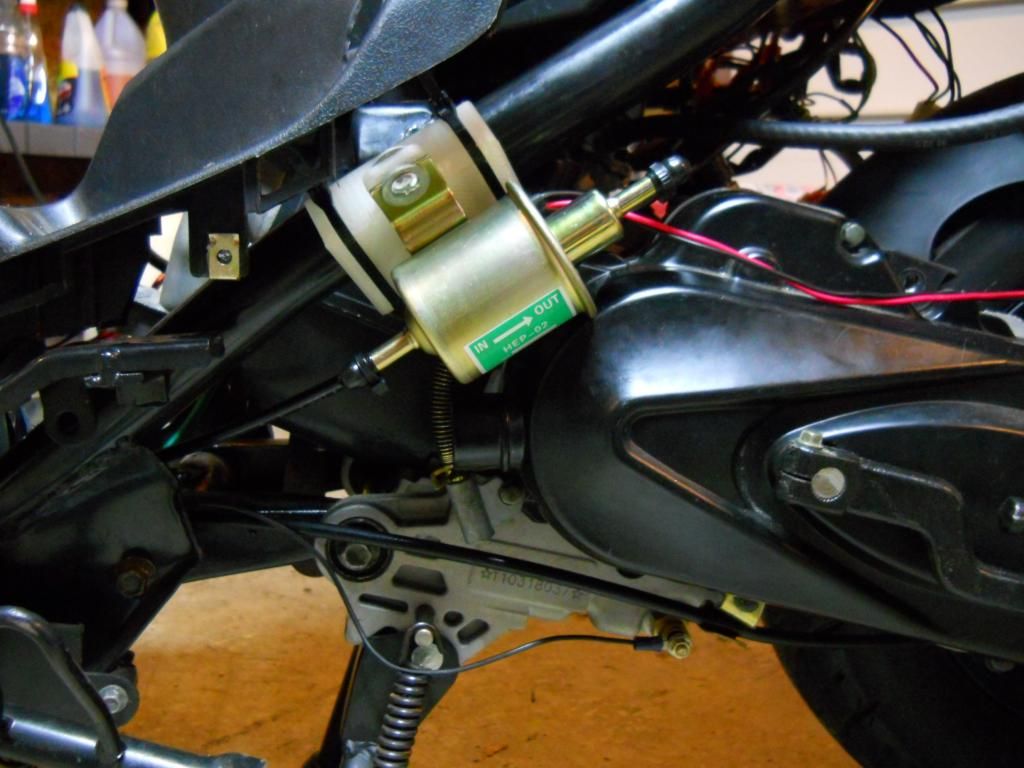 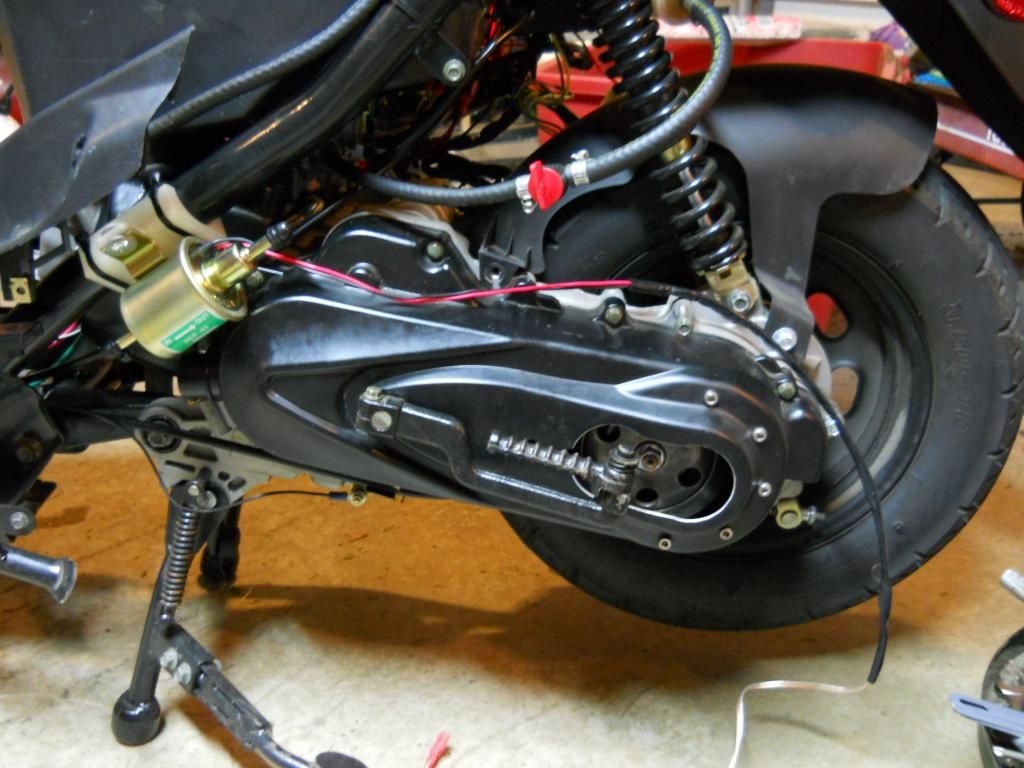 Just a note, the temperature reading will vary depending on the battery voltage, meaning it might read one temperature while riding and having the battery charged at 14.5 volts, and read another temperature after the engine has been turned off for a little while. |
|
Doc's Anything Goes
Currently Offline
Posts: 371  Likes: 18
Likes: 18
Joined: Jun 13, 2014 16:48:23 GMT -6
|
Post by glavey on May 21, 2015 18:03:00 GMT -6
Indeed! Now it's time to cook up some hot dogs on the grill, bake some beans, eat too much of both and make my room smell like a sulfur pit! Oh, and Alley, I posted that oil cooler summary in the tech section. I hope it isn't too long. |
|
Doc's Anything Goes
Currently Offline
Posts: 371  Likes: 18
Likes: 18
Joined: Jun 13, 2014 16:48:23 GMT -6
|
Post by glavey on May 21, 2015 15:55:14 GMT -6
I think I nailed it!
I went out, warmed up the engine with the 33 idle jet in the carb and the needle down one notch/clip one notch up from center. The hesitation and bogging were markedly improved, though still slightly present:
I lowered the needle/raised the clip one more notch to the top most position. Again, there was an even more pronounced improvement in acceleration from idle. The hesitation/bogging was only minutely present when the throttle was blipped after the engine had been idling for >30 seconds.
The engine was behaving excellently, but to get the highest idle, I had to have the mixture screw out 3 3/4 turns; a bit too much for my comfort. I put the 34 idle jet back in and moved the clip down to one notch above center.
The engine ran about the same as it did with the 33 idle jet and the clip one notch above center, but now there was almost no waiting for the engine to go back to idle after you snap the throttle closed, it just went straight to idle. Also, the mixture screw was only 2 1/2 turns out; perfectly acceptable.
Next I did what I did with the 33 jet, I put the clip in the highest position/needle in the lowest position, and retested. Perfection! Little if any hesitation, no waiting for the engine to come back down to idle.
I went out for a ride to test out the new tune. Much better acceleration from idle. I feel much less worried while at a stop light or stop sign with traffic behind me.
I am about half done with the oil cooler project summary; I'll probably have it done tonight. I'll post it in the tech contributions section when I'm done.
|
|
Doc's Anything Goes
Currently Offline
Posts: 371  Likes: 18
Likes: 18
Joined: Jun 13, 2014 16:48:23 GMT -6
|
Post by glavey on May 20, 2015 16:20:05 GMT -6
I didn't get too much done with the scooter today.
I removed the 30 idle jet, installed the 33, and raised the clip/lowered the needle. The hesitation got a bit better; I could blip the throttle after letting the engine idle for a while and it wouldn't bog as much, though it does still bog. The same is true for holding the throttle open until the hesitation stops, though the engine still doesn't go straight back down to idle after snapping the throttle closed, but it is much better then it was with the 30 and 32 idle jets.
I was just about to shoot a video of this; I got my cellphone out and saw I had a few new text messages. A family member had an unfortunate accident involving a pothole. Big heavy car + bad alignment + (inflated) worn old tire + pothole = worst alignment, deflated old tire, many curse words, and $300 in towing and tires.
After I got back from helping them and doing some grocery shopping for them, it was already 5pm, which is when I tend to stop working on my scooter (or any loud activity for that matter). I like to keep my neighbors happy.
I'll continue tuning and changing jets tomorrow. Perhaps I'll get started on the oil cooler summary tonight.
|
|
Doc's Anything Goes
Currently Offline
Posts: 371  Likes: 18
Likes: 18
Joined: Jun 13, 2014 16:48:23 GMT -6
|
Post by glavey on May 20, 2015 8:23:08 GMT -6
Ok, I will try to get that done today or tomorrow. I already have a thread for all of the mods I am doing to my scoot here, but it isn't focused just on the oil cooler. I'll type up a seperate summary dedicated to just the oil cooler project. I'm off to try and tame the carburetor. |
|
Doc's Anything Goes
Currently Offline
Posts: 371  Likes: 18
Likes: 18
Joined: Jun 13, 2014 16:48:23 GMT -6
|
Post by glavey on May 19, 2015 19:09:42 GMT -6
If I could put the stock air filter back on, I absolutely would. Unfortunately, the radiator and hoses for my oil cooler are in the way. 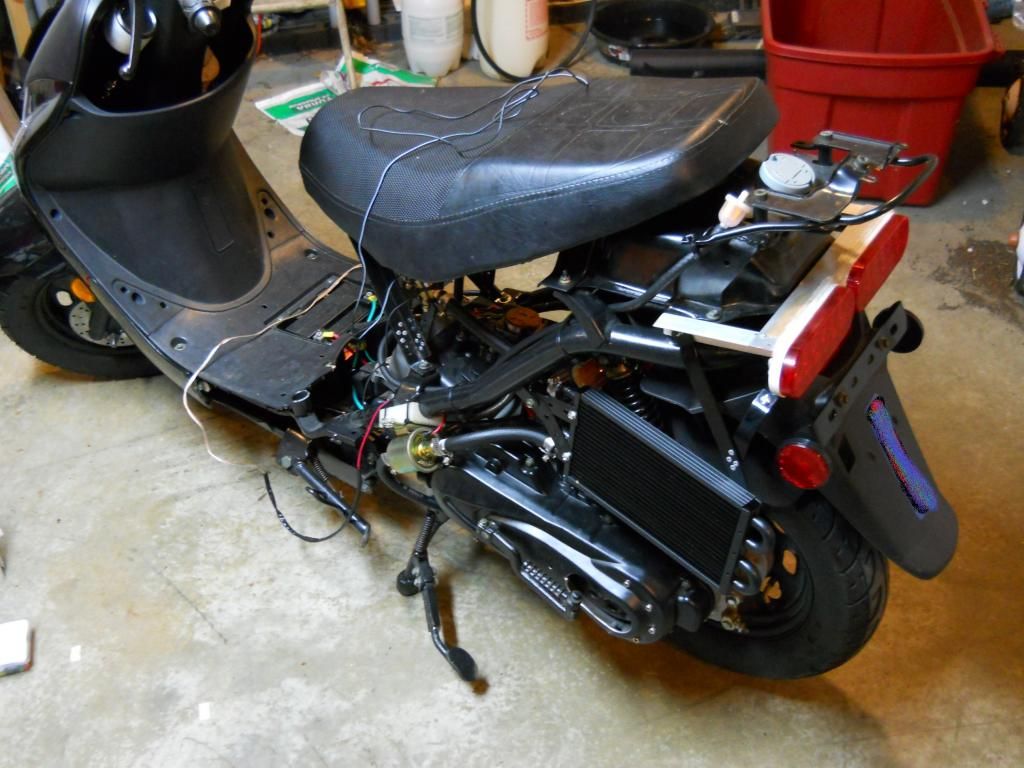 In fact they are what caused me to remove the stock airbox in the first place; there was no other way to route the hoses and position the radiator. I even designed and made my own airbox for the pod-style filter, but due to one small oversight (I took all of the measurements for its fitment with the scoot on the c-stand, forgetting that the engine with the carb on it moves a bit when taken off the c-stand) it didn't work. I still have the stock airbox, so I could try to either make it fit in some other place or make a pipe to put between the carb and the pod filter. Either way, tomorrow I will start with the 33 idle jet and try different needle positions. If no combination of idle jets and needle positions work, I'll move onto the air filter. If that doesn't work, then, unless I thought of something else by then... I'll just live with the hesitation. |
|

